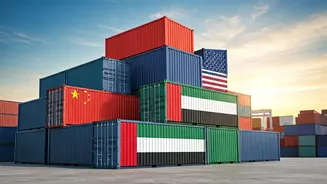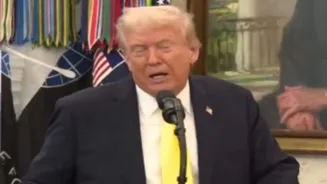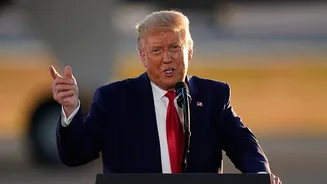US Tariffs Impact
Recent trade figures reveal that despite substantial US tariffs, India's exports experienced a 6% growth in September. However, the impact of these tariffs is
noticeable, leading to a 12% dip in exports to the US. This decline has prompted India to actively seek alternative markets. China and the United Arab Emirates have emerged as crucial partners, helping to soften the blow. This situation underscores the need for India to develop strategic partnerships. These alliances are critical for navigating the evolving global trade scene and building a resilient economy.
Trade Deficit Concerns
India's trade deficit has reached its highest level in a year, largely due to increased imports of gold, silver, and fertilizers. This widening gap between imports and exports highlights potential vulnerabilities in the country's economic balance. Examining the structure of imports and exports unveils how they affect the trade deficit. Strategic decisions will be needed to control import costs, encourage exports, and ensure sustainable economic growth. Addressing the trade deficit is essential for preserving economic stability and promoting long-term prosperity.
India's Export Strategy
With tariffs from the US, India is strategically reevaluating its export dynamics. The focus is to expand its reach and diversify its export destinations. By targeting new markets and solidifying relationships with countries like China and the UAE, India aims to shield its economy from external shocks. India is focused on bolstering its export competitiveness. This includes improving the quality of exported goods, optimizing logistical efficiency, and creating favorable trade agreements. These strategic moves will be crucial in ensuring that India's export sector continues to thrive in a global environment marked by change.
Modi-Trump Relations
The relationship between Prime Minister Modi and former US President Trump plays a central role in shaping India's trade policies. Understanding the dynamics of their interactions is important for deciphering the future trajectory of US-India trade relations. This involves monitoring the nuances of trade talks, the influence of tariffs, and the general economic stances of both leaders. It is important to comprehend how political connections affect the economic ties between the two nations and to foresee the future outcomes of their mutual approach toward trade and investment.
Energy Policy Implications
The energy policies of both India and the US, especially concerning oil imports, are directly impacted by trade dynamics. India's strategy for energy security is a key aspect, encompassing its approach toward purchasing oil from Russia and the potential repercussions of US tariffs. The focus is on finding a balance between meeting energy demands, protecting economic interests, and complying with international regulations. Changes in the energy sector will affect how India manages its relationships with various trading partners and ensures a steady supply of energy.
Ethanol Production Insights
India's initiative to boost ethanol production, mainly from grains rather than sugar, signifies a notable turn in its agricultural and energy strategies. This change is driven by a range of factors, including the desire for sustainable fuel options, environmental sustainability, and the necessity to lessen dependence on conventional fossil fuels. Such developments are anticipated to significantly affect the agriculture sector, influencing crop patterns, market dynamics, and farmers' earnings. This underscores India's push towards a more diversified and eco-friendly economic system.












